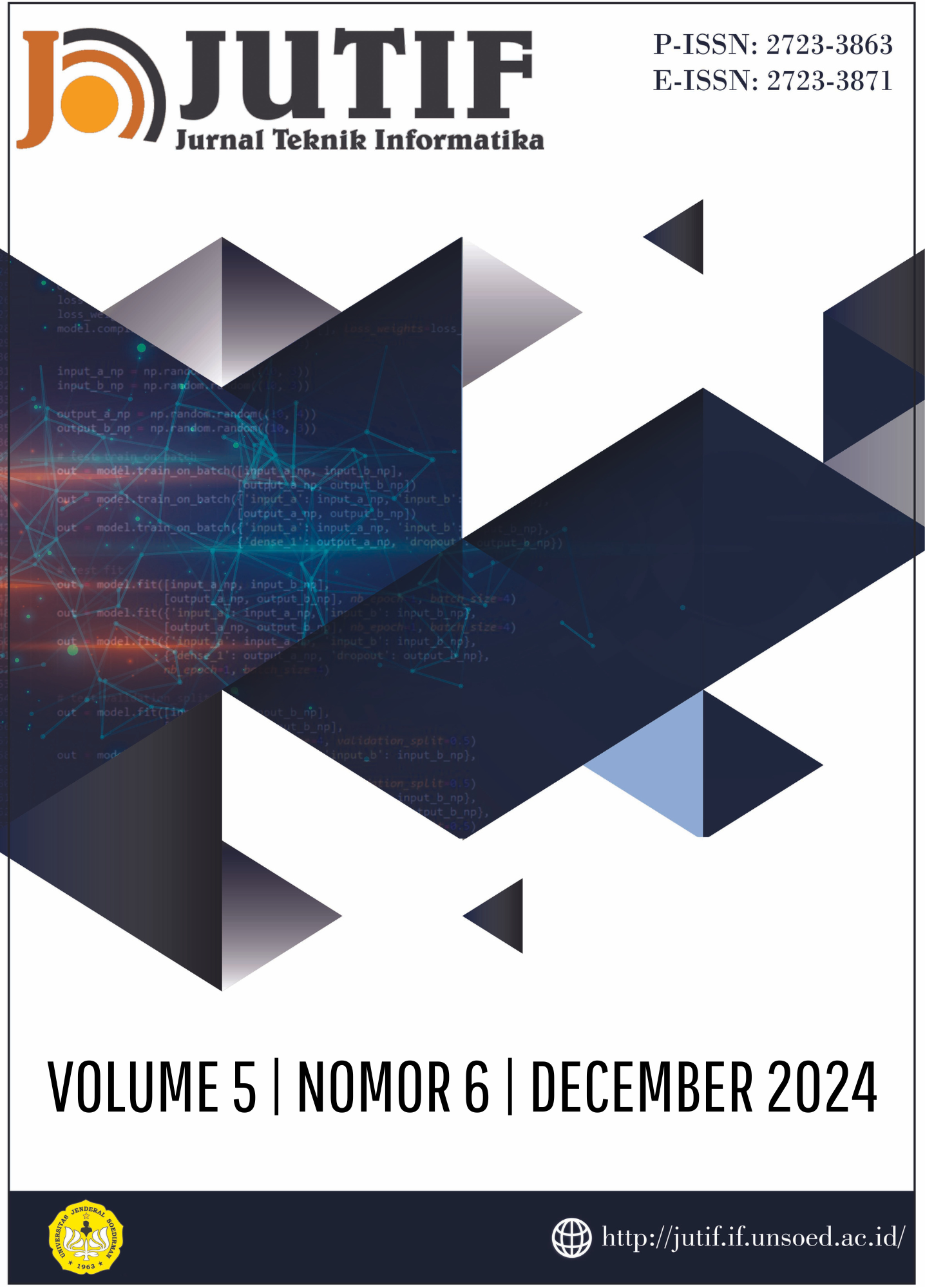DEVELOPMENT OF AN E-CANTEEN SYSTEM WITH EXTREME PROGRAMMING TO OPTIMIZE EFFICIENCY, TRANSPARENCY, AND ACCOUNTABILITY IN CANTEEN MANAGEMENT AT THE FACULTY OF ENGINEERING, MATARAM UNIVERSITY
DOI:
https://doi.org/10.52436/1.jutif.2024.5.6.3449Keywords:
digitally, E-Canteen, Extreme Programming, Information System, University of Mataram, XPAbstract
The e-Canteen system enhances efficiency and user experience in electronic-based canteen services. The study aimed to develop a platform streamlining transactions, inventory management, and interaction between customers and canteen service providers. Before implementation, critical issues identified included manual inventory management and slow ordering processes, which created inefficiencies. The system allows customers to order, pay, and track stock availability online, leading to a more efficient and convenient purchasing process. For canteen service providers, automated inventory management helps optimize stock control and reduces manual errors, promising a more streamlined and error-free operation. The E-Canteen system offers significant benefits to both customers and service providers. Customers enjoy a more efficient and convenient purchasing process, while service providers benefit from optimized stock control and reduced manual errors, fostering a more productive and error-free work environment. Additionally, BLU Unram can monitor canteen performance, enabling data-driven decisions to improve services and policies. The system was developed using the Extreme Programming (XP) method, which ensured a user-centered design and rapid adaptation to feedback. Findings from the study demonstrated a 30% improvement in operational efficiency, with user satisfaction significantly increased according to internal surveys. The E-Canteen system addresses the operational challenges of managing canteen services and integrates smoothly with modern technological advancements, providing a scalable and adaptive solution for future growth. This system effectively resolves issues in traditional canteen management, offering benefits to customers and service providers regarding efficiency, convenience, and service quality.
Downloads
References
B. B. Al-Kansa, M. L. Iswanda, N. Kamilah, and Y. T. Herlambang, “Pengaruh Kemajuan Teknologi Terhadap Pola Hidup Manusia,” Indo-MathEdu Intellectuals J., vol. 4, no. 3, pp. 2966–2975, 2023, doi: 10.54373/imeij.v4i3.682.
D. S. Kania, D. M. Afirahmi, D. P. Nuria, and D. Yusup, “Perancangan dan Pengembangan Aplikasi E(AT)VERYDAY sebagai Sistem Pemesanan Kantin Berbasis Website,” Innov. J. Soc. Sci. Res., vol. 3, no. 3, pp. 518–528, 2023.
J. Simuka, T. Marume, T. Mzembi, and S. Tagwi, “Role of Technology to Improve the Effectiveness of University Canteen Systems,” J. Bus. Economy. Stud., no. April, pp. 1–6, 2024, doi: 10.61440/jbes.2024.v1.13.
S. Pramudito and R. Budihardjo, “Evaluasi Desain Kantin Berdasarkan Preferensi Mahasiswa: Sebuah Analisis ISI,” J. Arsit. Arcade, vol. 6, no. 1, pp. 120–128, 2022.
B. C. Neyfa and D. Tamara, “Perancangan Aplikasi E-Canteen Berbasis Android Dengan Menggunakan Metode Object Oriented Analisys & Design ( OOAD ) ‘ E - Canten ’ Android -Based Application Design Using Object Oriented Analysis & Design Method tempat makan pada umumnya , dimana Area k,” Penelit. Komun. dan Opini Publik, vol. 20, no. 1, pp. 83–91, 2018.
M. Y. H. Setiwan et al., “Kantin Pintar Universitas Hasanuddin Berbasis Web Web-Based Hasanuddin University Smart Canteen,” SainstTech Innov. J., vol. 5, no. 2, pp. 285–292, 2022.
D. T. Absari, L. Liliana, D. Soesanto, and Susana Limanto, “Repeat Order Recommendation Model To Digitalize the Canteen,” J. Bisnis Terap., vol. 7, no. 1, pp. 1–10, 2023, doi: 10.24123/jbt.v7i1.5336.
A. Shrivastava, I. Jaggi, N. Katoch, D. Gupta, and S. Gupta, “A Systematic Review on Extreme Programming,” J. Phys. Conf. Ser., vol. 1969, no. 1, 2021, doi: 10.1088/1742-6596/1969/1/012046.
A. Andriani and J. F. Andry, “Designing a Web-Based Inventory Application at General Steel Supplier Using Extreme Programming Method,” CogITo Smart J., vol. 9, no. 1, pp. 15–27, 2023, doi: 10.31154/cogito.v9i1.479.15-27.
N. A. Septiani and F. Y. Habibie, “Penggunaan Metode Extreme Programming Pada Perancangan Sistem Informasi Pelayanan Publik,” J. Sist. Komput. dan Inform., vol. 3, no. 3, p. 341, 2022, doi: 10.30865/json.v3i3.3931.
D. J. C. Sihombing, “Enhancing Village-level Inventory Management through Extreme Programming: A Case Study in Rural Empowerment,” J. Info Sains Inform. dan Sains, vol. 13, no. 03, pp. 1072–1079, 2023.
N. Eldanasory, E. Yehia, and A. M. Idrees, “A Literature Review on Agile Methodologies Quality, eXtreme Programming and SCRUM,” Futur. Comput. Informatics J., vol. 7, no. 2, pp. 24–32, 2022, doi: 10.54623/fue.fcij.7.2.3.
R. Rudianto, “Penerapan Metode Extreme Programming Dalam Pembangunan Aplikasi Sistem Penunjang Keputusan,” J. Sist. Inf. dan Bisnis Cerdas, vol. 16, no. 1, pp. 21–30, 2023, doi: 10.33005/sibc.v16i1.6.
L. Williams, Agile Software Development Methodologies and Practices, 1st ed., vol. 80, no. C. Elsevier Inc., 2010. doi: 10.1016/S0065-2458(10)80001-4.
R. Kustiani, Y. Syahidin, and ..., “Electronic Medical Record Information System Design To Support the Reporting of Completeness of Bpjs Patient Medical …,” J. Tek. Inform. …, vol. 5, no. 4, pp. 11–19, 2024, [Online]. Available: https://www.jutif.if.unsoed.ac.id/index.php/jurnal/article/view/1976
A. Nur et al., “Development of Application Programming Interface (Api) for Amikom Purwokerto Handsanitizer (Ampuh) Data Logger Visualization,” J. Tek. Inform., vol. 3, no. 3, pp. 791–796, 2022, [Online]. Available: https://doi.org/10.20884/1.jutif.2022.3.3.222
W. Wulandari, N. Nofiyani, and H. Hasugian, “User Acceptance Testing (Uat) Pada Electronic Data Preprocessing Guna Mengetahui Kualitas Sistem,” J. Mhs. Ilmu Komput., vol. 4, no. 1, pp. 20–27, 2023, doi: 10.24127/ilmukomputer.v4i1.3383.
V. Revaldy, “Pengembangan Aplikasi E-Canteen Dengan Pembayaran Non-Tunai Berbasis Android Untuk Siswa (Studi Kasus: Sma Negeri 5 Malang),” J. Pengemb. Teknol. Inf. dan Ilmu Komput. Vol., vol. 4, no. 6, pp. 1924–1932, 2020.
Siti Purnama, K. A. Hafizd, and R. Sayyidati, “Sistem Informasi Kantin Elektronik (E-Canteen) Politeknik Negeri Tanah Laut Berbasis Web Mobile,” Antivirus J. Ilm. Tek. Inform., vol. 14, no. 2, pp. 73–85, 2020, doi: 10.35457/antivirus.v14i2.1124.




























